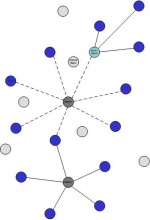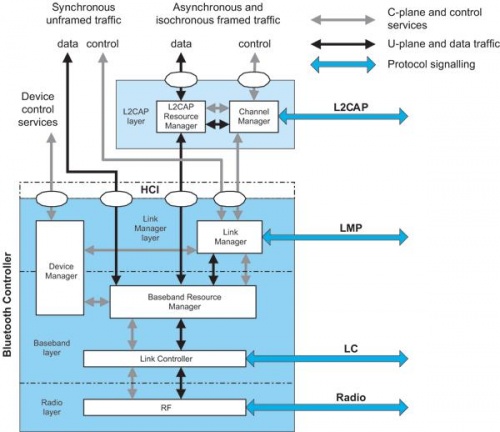Bluetooth
From Computing and Software Wiki
The Bluetooth was developed in 1994 by Sven Mattisson and Jaap Haartsen, working for Ericsson Mobile Platforms in Lund, Sweden.
Bluetooth was named after a late tenth century king, Harald Bluetooth, King of Denmark and Norway. He is known for his unification of previously warring tribes from Denmark (including Scania, present-day Sweden) and Norway. Bluetooth likewise was intended to unify different technologies, such as computers and mobile phones.
Bluetooth offers services that enable the connection of devices and the exchange of a variety of data classes between these devices. Bluetooth wireless technology is a short-range communications system mean to substitute the wires connecting electronic devices. It is a standard that wirelessly connects mobile phones, portable computers, cars, stereo headsets, MP3 players, and more. The key features of Bluetooth wireless technology are robustness, low power, and low cost. The specifications were formalized on May 20, 1998, by the Bluetooth Special Interest Group (SIG).
Contents |
The Technology
Band of Emission
The Bluetooth RF (Radio Frequency) operates in the unlicensed ISM 5Industrial, Scientific and Medical) band at 2.4GHz to 2.485GHz using 79 channels at 1MHz intervals to give a good interference immunity. The system utilizes a frequency hop transceiver, full-duplex signal at a nominal rate of 1600 hops/sec, to reduce interferences, and provides many FHSS (Frequency Hop Spread Spectrum) carriers. By detecting and avoiding the frequencies the others devices are using, the AFH (Adaptive Frequency Hoping) runs through the available frequency. This adaptive hopping allows for more efficient transmission within the spectrum, providing users with greater performance even if using other technologies along with Bluetooth technology
Range
The operating range depends on the device class:
- Class 1 radios:
- Used primarily in industrial use cases
- Have a range of 100 meters or 300 feet
- Maximum Permitted Power: 100mW/20dBm
- Class 2 radios:
- Most commonly found in mobile devices
- Have a range of 10 meters or 33 feet
- Maximum Permitted Power: 2.5mW/4dBm
- Class 3 radios:
- Have a range of up to 1 meter or 3 feet
- Maximum Permitted Power: 1mW/0dBm
Bluetooth Baseband - Networking
Bluetooth communication occurs between a master radio and a slave radio. Bluetooth radios are symmetric in that the same device may operate as a master and also the slave. Each radio has a 48-bit unique device address that is fixed.
Piconet
When two Bluetooth devices are linked, a piconet is created. A piconet is a mini network, composed by two or more devices, and has a star topology. The devices occupy the same physical channel, hence they are synchronized to a common clock and hopping sequence. The common clock is the clock of one of the device, named the master and the hopping sequence depends on the master’s clock and the master’s device address. The other devices are named slaves. There are two kinds of slaves. The usual slave and the parked or inactive slaves. These ones don't interact, for now, with the master. Each piconet has a different physical channel and independant piconet clock and hopping sequence; because it is a different master device each time.
A master is allowed to have at the most seven active devices and 255 parked slaves. To switch from on device to another, the master uses the technique of round-robin.
Scatternet
A Bluetooth device can interact more than one piconet.
This is done on a time-division multiplexing basis.
A Bluetooth device can't be a master for more than one piconet but it can be slave in more than one.
Each node can serve both as a host and as a router. Thus, any device in a piconet can connect to a device in an adjacent piconet.
The Architecture
Radio Layer
The RF (Radio) block transmits and receives packets of information. Its timing and frequency carrier is control by the Baseband block (Lin Controller + Baseband Resource Manager) thanks to a control path between the two. The RF block transforms a stream of data, coming between the RF and the Baseband, into required formats.
Link Controller
The link controller is in control of the encoding and decoding of Bluetooth packets from the physical channel, logical transport and logical link. It also permits to communicate flow control, acknowledgement and retransmission request signals, with the link control protocol.
Baseband Resource Manager
The access to the radio medium is controlled by the baseband resource.
It has two main functions:
- A scheduler that grants time on the physical channels to all of the entities that have negotiated an access contract.
- Negotiate access contracts (commitment to deliver a certain Quality of Service - QoS) with these entities.
Link Manager
The creation, modification and release of logical links and associated transports are controlled but the link manager. It communicates using the Link Management Protocol (LMP) to the link manager in the Bluetooth devices. LMP permits to create new logical links and transports between devices and control link and transports attribute.
Device Manager
The device manager controls the general behaviour of the Bluetooth enabled device. All the operation not directly related to data transport (like the research or the connection to other Bluetooth devices) are controlled by the device manager.
L2CAP Resource Manager
The L2CAP resource manager block controls the management to order submission of Protocol Data Unit fragments (PDU) to the baseband, schedules between channels to ensure that L2CAP channels with QoS are allowed to access the physical channel.
Channel Manager
Creation, management and deletion of L2CAP channels for the transport of service protocols and application data streams are controlled by the channel.
It uses the L2CAP protocol to interact with a channel manager on a device to create these L2CAP channels and connect their endpoints to the appropriate entities.
Data Transport
Bluetooth Profiles
References
See also
External links
--Morsall 15:18, 12 April 2009 (EDT)





